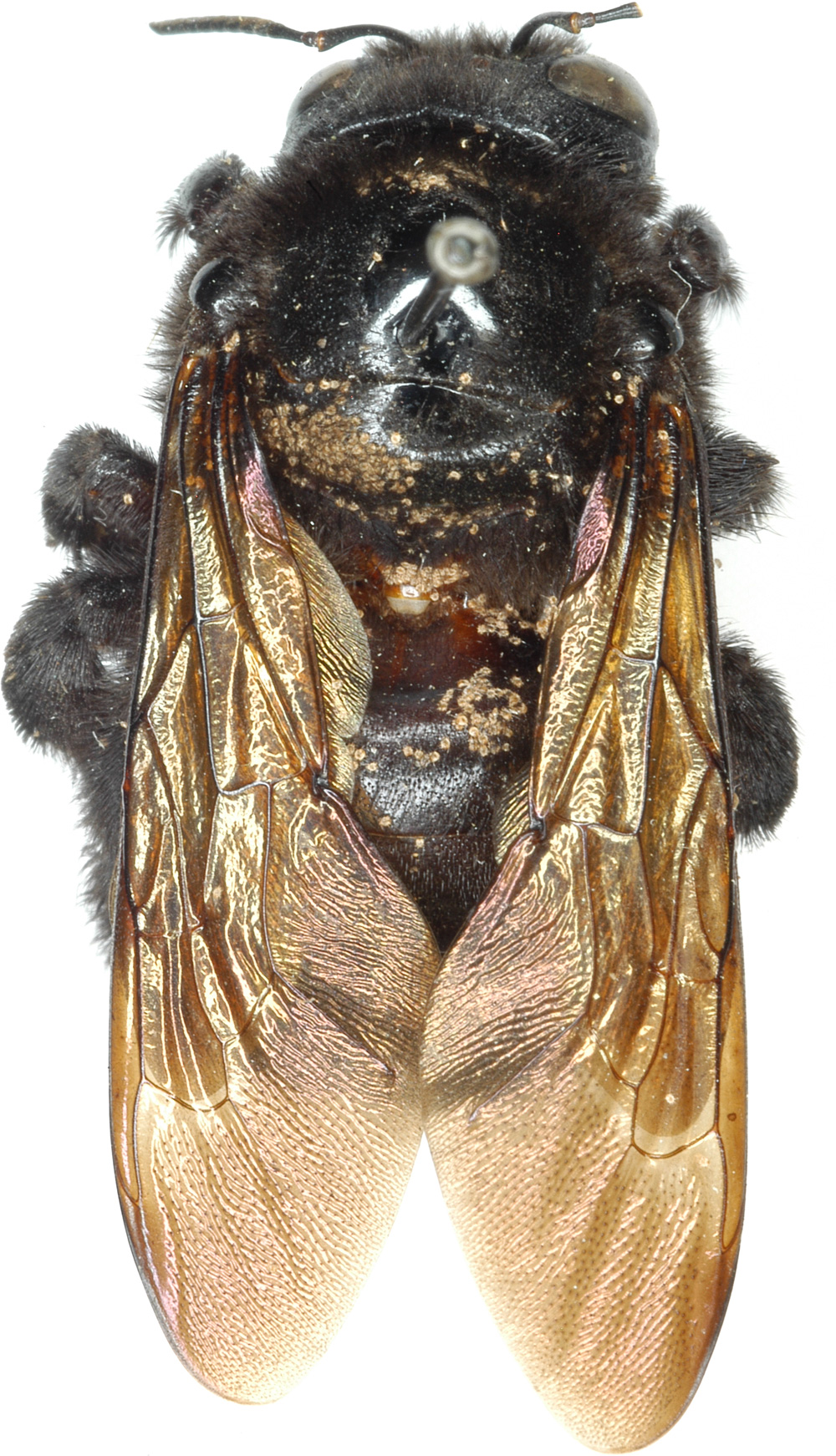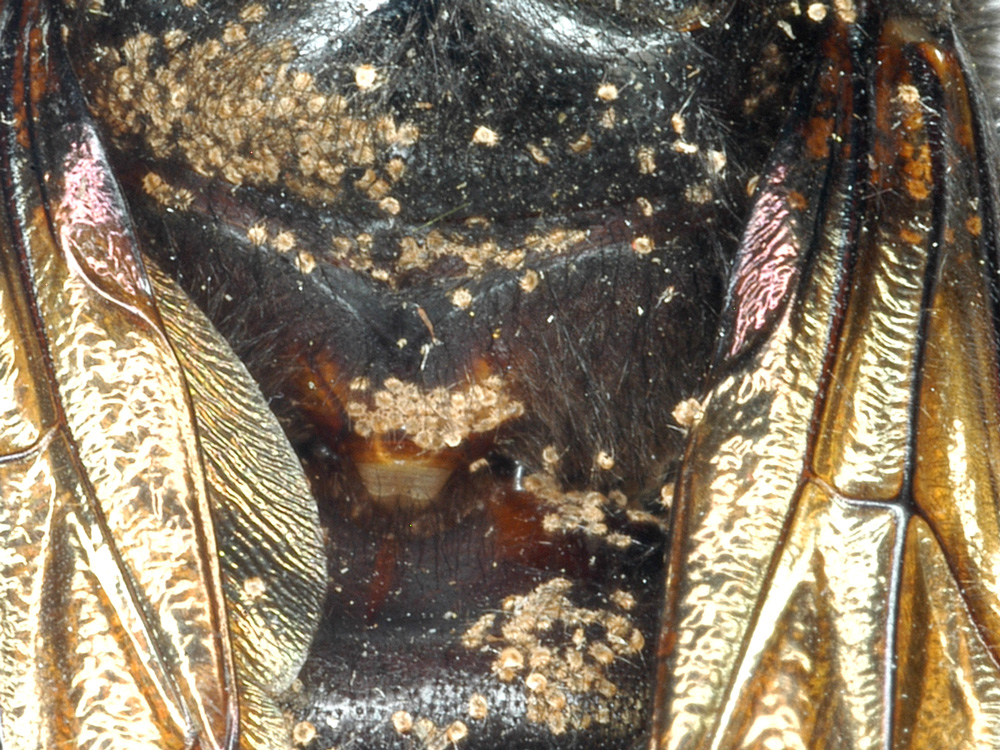Bee Mites : Acari : Acariformes : Sarcoptiformes : Chaetodactylidae : Sennertia : Sennertia species
Sennertia shimanukii Baker and Delfinado-Baker, 1983
Sennertia shimanukii: Baker & Delfinado-Baker, 1983: 117, Figs 1-6 (holotype and 37 (36 indicated originally) paratype HDNs in USNM); Ramaraju & Mohanasundaram, 2001: 107; Alzuet & Abrahamovich, 1987: 350; Klimov & OConnor, 2008: 176, Figs 92-93
Sennertia shimanuki Alzuet & Abrahamovich, 1990: 630 (lapsus)
Material (show database records). (number of specimens measured for morphometric analysis (Klimov & OConnor, 2008, p. 81) in parentheses). Holotype HDN (wash) and 37 paratypes (wash, body hairs) - GUATEMALA: Sololá, San Lucas Tolimán, ex Apis mellifera, 1 Oct 1980, J. Cummings, USNM, BMOC 04-0822-004 (16 analysis); 12 HDNs - MEXICO: Baja California Sur, 2 mi S La Paz, ex Xylocopa californica arizonensis on propodeum, 6 Aug 1966, P. D. Hurd, USNM, BMOC 05-0420-096 (5 validation); 28 HDNs - Nayarit, Islas Tres Marías, Islas Maria Cleofas, ex X. varipuncta on 1st metasomal tergite, 27 Mar 1964, R. R. Snelling, 364 LACM ENT 208598, BMOC 05-0102-034 (5 validation); 16 HDNs – same data LACM ENT 208599, BMOC 05-0102-035 (5 validation); 30HDNs - Veracruz, Cotaxtla, ex X. fimbriata on 1st metasomal tergite, 5 Jul 1962, D. H. Janzen, USNM, BMOC 05-0420-154 (5 validation); 15+22 HDNs - USA: Texas, Hidalgo Co., ex X. mexicanorum on scutellum & metanotum + propodeum & wing bases, 8 Jun 1958, D. J. & J. N. Knull, OSU OSUC 0121357, BMOC 03-1106-088 (10 analysis, 5 revalidation); 18HDNs - Hidalgo Co., Hidalgo, ex X. mexicanorum on wing bases and propodeum, Apr 1939 (year illegible), Stanley Mulall (last letters illegible), USNM, BMOC 05-0420-075 (9 analysis); 28HDNs - Cameron Co., Brownsville, ex X. mexicanorum on metanotum, no date, no collector, USNM, BMOC 05-0420-269 (10 analysis); 19HDNs - ex X. mexicanorum on metanotum, no date, C. F. Baker, USNM, BMOC 05-0420-270 (4 analysis); 16HDNs - Cameron Co., Brownsville, ex X. mexicanorum on scutellum, 28 May 1904, H. S. Barber USNM, BMOC 05-0420-271 (9 analysis); 17 HDNs – same locality, ex X. varipuncta under tegulae, no date, G. Dorner, INHS Insect Collection 62490, BMOC 04-1222-150 (5 validation); 19 HDNs - ex X. varipuncta on 1st metasomal tergite, no date, INHS Insect Collection 62492, BMOC 04-1222-152 (5 validation); 21HDNs - California, Alameda Co., Oakland, Balsawood, ex X. sonorina on scutellum, 11 Aug 1940, R. M. Hayes, USNM, BMOC 05-0420-365 (5 validation); 3HDNs - San Bernardino Co., ex f X. varipuncta, 1-7 Apr 1918, J. C. Bradley, CUIC HK 84-1217-001. Voucher specimens in CUIC, INHS, LACM, OSAL, UMMZ, UNAM, USNM.
Description. Phoretic deutonymph. Gnathosomal solenidia shorter than 1/3 of femur I width. Supracoxal setae scx situated on separate small sclerite. Hysterosomal shield lateral gland openings and bases of f2 nearly on edge of hysterosomal shield, or the former outside the shield. Lateral edges of hysterosomal shield in anterior part not narrowing. Dorsal hysterosomal pouch absent. Distance between anterior margin of hysterosomal shield and setae si exceeds diameter of si bases. Striate pattern of idiosomal cuticle outside hysterosomal shield without sclerotization, formed by long striae. Distinct rudiments of vi present. Setae si distinctly posterior se, exceed 1/2 of se, almost as thick as se. Diameter of si exceeds 1/2 of diameter of se. Setae c1 distinctly longer than d1-h1; long, nearly as long as se; situated on anterior edge of hysterosomal shield. Setae d1 and e1 nearly uniform in length with h1; situated on hysterosomal shield. Sclerite between ia and d2 present. Setae e2 subequal with d2; not touching hysterosomal shield. Lateral gland openings situated on hysterosomal shield. Setae 4b, g, and 4a with rhomb-like widening (sometime weakly-developed). Setae 4b, pR I-II, sR III, wF IV, gT I-II, hT I-II, kT III, ra I-II filiform. wa I-II spiniform. Posterior apodemes II and anterior apodemes III free. Anterior apodemes IV not interrupted; almost straight. Posterior apodeme IV absent. Conoids ps2 posterior to anterior transverse level of central suckers (ad1+2); anterior to ps1, situated outside outer level of ad1+2. Transparent margin of anterior suckers (ad3) without rough sclerotization. Suckers ad3 not enlarged, smaller than central suckers. Posterior and lateral borders of attachment organ not forming distinct frame. Sclerotized rudiment of anterior cuticular suckers present. Longitudinal hysterosomal sclerite present, long. Ventral hysterosoma smooth. Genual setae mG I-II simple, mG II distinctly shorter than leg II, but longer than femur II. Tarsal setae la I-II longer than famulus ε. Tarsal setae ra I-II not bifid, filiform. Tarsal setae wa I-II and s III spiniform (at least s III with rounded apices). Tarsal setae d I-II distinctly widened, lanceolate. Tarsal setae d and f I-II almost symmetrical, d and f I not touching. Solenidion ω3 closer to f I than to ω1. Posterior condylophore present. Anterior condylophore I-II with distal bending. Seta d III situated close to tarsal base, distance usually subequal or shorter than diameter of d III alveolus. Leg IV protruding posterior edge of hysterosoma. Tarsus IV not enlarged, shorter or less than 2 times longer than width of trochanter IV. Setae w IV thinner than d IV and distinctly shorter than leg IV, situated on middle of tarsus IV. Setae s IV present. Setae wF IV slightly protruding apex of tarsus IV.
Other instars unknown.
Hosts. Apis mellifera (type host, accidental); Xylocopa (Neoxylocopa) varipuncta, Xylocopa (Neoxylocopa) mexicanorum, Xylocopa (Neoxylocopa) sonorina, Xylocopa (Xylocopoides) californica arizonensis, Xylocopa (Neoxylocopa) fimbriata (Apidae).
Distribution (Show map). Guatemala: Sololá (type locality); Mexico: Baja California Sur, Nayarit, Veracruz; USA: California, Texas.
Note. Similar to Sennertia augustii and S. frontalis (see p. 84)
References
Abrahamovich, A. H. & A. B. Alzuet de. 1990. Tipos de asociación entre acaros e Hymenópteros. I: Sennertia (A.) splendidulae Alzuet y Abrahamovich, 1988 (Acarina: Chaetodactylidae) comensal y forético de Xylocopa (S.) splendidula splendidula Lepeletier, 1841 (Hymenoptera: Anthophoridae). Turrialba.40: 319-322.
Alzuet, A. B. d. & A. H. Abrahamovich. 1987 [1985]. Deutoninfas (hypopi) de los géneros Sennertia Oudemans, 1905 y Horstia Oudemans, 1905 (Acari: Astigmata) sobre Xylocopa (S.) splendidula splendidula Lepeletier, 1841 (Hymenoptera: Apoidea). Revista de la Sociedad Entomologica Argentina.44: 345-351.
Baker, E. W. & M. Delfinado-Baker. 1983. New mites (Sennertia: Chaetodactylidae) phoretic on honey bees (Apis mellifera L.) in Guatemala. International Journal of Acarology.9: 117-121.
Klimov, P. B. & B. M. OConnor. 2008. Morphology, evolution, and host associations of bee-associated mites of the family Chaetodactylidae (Acari: Astigmata), with a monographic revision of North American taxa. Miscellaneous Publications Museum of Zoology University of Michigan.199: 1-243.
Ramaraju, K. & M. Mohanasundaram. 2001. New phoretic mites (Acari: Chaetodactylidae) on carpenter bees from Tamil Nadu, India. International Journal of Acarology.27: 107-112.
Image Gallery
B. OConnor and P. Klimov ©
Created: May 26, 2011
Last modified: 



